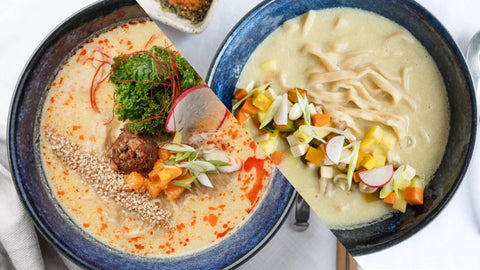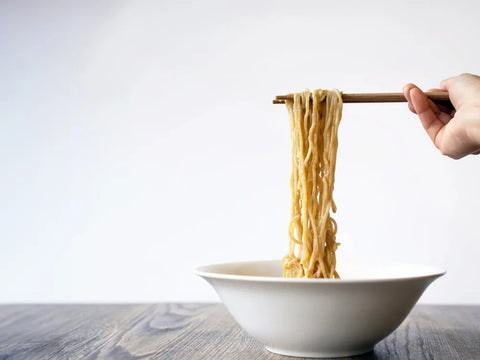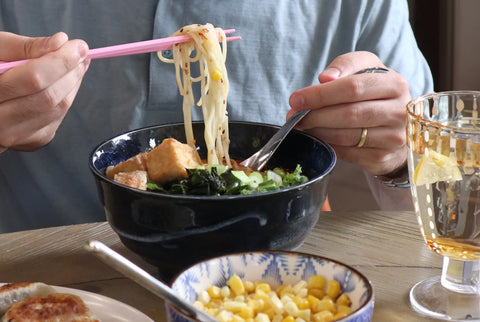Noodles hold a revered place in Japanese cuisine, embodying both tradition and culinary innovation.
Among the diverse array of noodle dishes, udon noodles and ramen noodles stand out as two of the most common, popular and iconic.
While both are beloved for their unique flavours and textures, the differences between them go far beyond just thickness.
These noodles are enjoyed in countless ways, reflecting the rich cultural tapestry of Japan.
Whether you prefer ramen's chewy, kansui noodles or udon's smooth, vegan-friendly strands, we'll explain their fascinating distinctions and similarities.
It's time to show you the full story behind udon noodles and ramen noodles.
You can make your final decision which might become your new favourite at the end of this article
Key Takeaways:
- Learn the main ingredients and popular dishes for ramen and udon noodles.
- Discover the differences in preparation methods and textures.
- Explore the unique broths and culinary uses for each noodle type.
What Are Ramen Noodles?
Ramen noodles are a popular type of Japanese noodle known for their unique bouncy texture, aroma and flavour.
They are often used in soups and stir-fries, making them a versatile choice in Japanese cuisine.
What are the main ingredients in ramen noodles?
Ramen noodles are made from three main ingredients: wheat flour, alkaline water (kansui), and salt.
Wheat flour gives the noodles their structure and chewiness. Alkaline water, or kansui, is the key ingredient that sets ramen apart from other noodles.
It gives the noodles their distinctive yellow colour and firm texture. Salt is added to enhance the flavour and help with the dough's elasticity.
What are popular vegan ramen dish options?
There are several delicious vegan ramen dishes to try:- Vegan Spicy Tan Tan Ramen: This ramen has a spicy sesame broth, topped with mushrooms, vegetables and greens.
- Vegan Shio Ramen with Garlic: A light and savoury broth with seaweed, tofu, and vegetables.
- Vegan miso ramen: This dish features a nutty savoury miso broth topped with tofu, and vegetables.
What Are Udon Noodles?
Udon noodles are a popular type of Japanese noodle known for their thick and chewy bite.
They are often used in various dishes and can be enjoyed both hot and cold.

What are the main ingredients in Udon noodles?
The main ingredients in udon noodles are wheat flour, salt and water. Its simplicity is appreciated with purists, children and people who prefer plant-based cuisine. The very few ingredients in the noodles give udon its idealistic, thick texture and make it a versatile option in many dishes. The dough is kneaded and then cut into thick strips before being boiled. There are in fact, many different thicknesses even within the variety of udon noodles.These simple ingredients give udon its unique, thick texture and make it a versatile option in many dishes.
The dough is kneaded and then cut into thick strips before being boiled.
What are popular vegan Udon dish options?
There are several delicious vegan udon dishes you can try:- Vegan Tempura Udon: This dish features udon noodles in a light broth, umami derived from konbu, topped with crispy tempura vegetables.
- Vegan Curry Udon: Udon noodles are served in a rich, savoury curry broth, often with vegetables like carrots and potatoes.
- Vegan Yaki Udon: Stir-fried udon noodles with vegetables and a savoury sauce.
- Vegan Udon Salad: Stir-fried udon noodles with vegetables and a savoury sauce.
Learn more about udon noodles and explore the variety of dishes you can create with these versatile noodles.
How Do Ramen and Udon Noodles Differ in Preparation Methods?

How are ramen noodles prepared?
To prepare ramen noodles, you need to cook them in boiling water. The cooking time is quick, usually around 3 to 5 minutes.
For raw noodles that haven’t been dried, it could be shorter. The short cooking time ensures the noodles remain firm and springy.
When boiling ramen noodles, make sure to use a large pot of water. (Similar to pasta!) This helps the noodles cook evenly.
Stir occasionally to prevent sticking. Once boiled, drain the noodles and rinse them under cold water to stop the cooking process and remove excess starch.
You can then add the noodles to your broth, stir-fry or salad.
How are Udon noodles prepared?
The preparation method for udon noodles also involves a large pot of boiling water.
The cooking time is longer because of their thicker nature. It usually takes around 8 to 12 minutes for dry noodles and 4-6 minutes for raw noodles.
Stir occasionally to prevent sticking. After cooking, drain the noodles and rinse them under cold water.
This helps maintain their chewy texture and stops the cooking process.
Udon noodles can be then added in hot soups, broths, cold salads, or stir-fry.
The Different Characteristics of Ramen and Udon Noodles.
Ramen and udon noodles are both popular Japanese noodle varieties.
They each have unique textures and characteristics that make them stand out in Japanese cuisine.
Characteristics of Ramen noodles
Ramen noodles are thin, long and firm. They are made from wheat flour, alkaline water (kansui), and salt.
The alkaline water gives them their springy, chewy texture and yellow colour.
There are many varieties in shapes. Some can be straight or wavy and differs in thickness. When cooked, ramen noodles have a springy bite.
This makes them ideal for ramen noodle soup and other dishes.

Characteristics of Udon noodles
Udon noodles are thick and chewy. They are made from wheat flour, salt, and water.
Unlike ramen, udon noodles are much thicker, sometimes wavy, even flat.
Their chewy texture comes from the way they are kneaded and cooked. Udon noodles are perfect for udon noodle soup and other recipes.
They are appreciated for their absorbent, smooth texture. Both types of noodles have their own charm.
Ramen is great for a quick, satisfying chew with a rich broth, while udon offers a voluminous bite.
For more on the texture of these noodles, check out this dehydrated ramen noodles.
What Are Some Broths Enjoyed with Plant-Based Ramen and Udon Noodles?
Ramen and udon noodles each have unique broths that elevate the texture and flavour of the noodles. Let's dive into the common vegan broth options.
What are common vegan ramen broths?
Vegan Spicy Tan Tan Broth: This broth is a rich and spicy blend, made from a base of sesame paste and chilli oil. It delivers a creamy texture with a bold, fiery kick, perfect for enhancing the flavours of ramen noodles.
Shio Broth with Garlic Flavour: Savoury umami broth, light and clear with a delicate balance of flavours. Infused with garlic, provides a savoury, aromatic twist that complements the simplicity of udon or ramen noodles.
Miso broth: Miso broth is a savoury and rich broth made from fermented soybeans. It has a deep flavour that pairs well with noodles that has the ability to soak up umami.
Soy sauce broth: Soy sauce broth, is made by blending soy sauce with a vegetable or konbu stock. It offers a light yet flavourful base for ramen dishes.
What are some vegan udon broth options?
Mushroom broth: Mushroom broth is made from simmering various mushrooms like shiitake and maitake. It gives a deep, earthy flavour to the broth and udon noodles.
Kombu dashi: Kombu dashi is a broth made from sea kelp, providing a light and clean taste. It's a traditional base for many udon noodle dishes and any broth.
How is udon used in different dishes?
Udon noodles are thick and chewy, making them ideal for hot soups.
In hot soups, udon noodles are often combined with mushrooms, tofu, and green onions.
These ingredients enhance the flavour and make the dish more filling. Udon can also be used in cold salads.
Cold udon salads are refreshing and perfect for warmer days.
They often include ingredients like cucumbers, sesame seeds, and a light soy-based dressing.
Both hot and cold udon dishes offer a unique culinary experience.
Where are Ramen and Udon Noodles Originated?
Ramen and udon noodles are two popular staples of Japanese cuisine, each with its unique history and cultural significance.
Let’s get into the origins of these beloved noodles and explore how they have evolved over the centuries.
What is the origin of ramen noodles?
Ramen noodles have a fascinating history that begins in China. They were brought to Japan in the late 19th century.
Chinese wheat noodles made their way to Japan through Chinese tradesmen and eventually became a culinary sensation.
They were initially known as "Chinese soba." Japan adopted ramen and made it their own and the first ramen shop in Japan is said to have opened in Yokohama in 1910.
This was the beginning of the ramen craze in the country. Over time, ramen evolved into a beloved comfort food in Japan, with regional variations and styles emerging across the country.
The secret to ramen’s popularity lies in its versatility. Today, ramen is enjoyed worldwide, with each chef and city putting its unique spin on this classic dish.
It is enjoyed in various forms, from street food to gourmet dishes.
What is the origin of udon noodles?
Japan is the home of udon noodles. These thick, chewy noodles have been a staple in Japanese cuisine for centuries.
Udon's origins date back to the Nara period (710-794 AD). It is believed that a Buddhist monk introduced the noodle-making technique that was brought from China.
The city of Shikoku is often credited as the birthplace of udon noodles, where the noodles are traditionally handmade and served with a simple broth with minimal toppings.
Udon noodles are not only enjoyed in soups but also in stir fries, hot pots, and cold noodle salads.
The simplicity and comfort of udon noodles have made them a favourite among both locals and visitors to Japan.
What Flavours Are Unique to Ramen and Udon Noodles?
Ramen and udon noodles each bring their own unique flavours to the table.
Ramen flavours are often bold and complex.
Ramen noodle dishes usually feature broths made from soy sauce, miso, or even spicy ingredients.
These broths create a savoury and sometimes spicy taste that many love.
The noodles themselves, made from wheat flour, alkaline water (kansui), and salt, have a firm texture that holds up well in rich broths.
Udon flavours, on the other hand, are more subtle and delicate.
Udon noodle dishes often use lighter broths like kombu dashi or mushroom broth.
These broths bring out a gentle umami flavour, making the thick, chewy noodles the star of the dish.
Udon noodles, made from wheat flour, salt, and water, are known for their smooth and satisfying texture.
In Japanese cuisine, ramen and udon are popular types of noodles, each offering a different culinary experience.
Noodle Showdown! Wrap up the difference between udon and ramen noodles!!

Whether you prefer the intense flavours of ramen or the mild, comforting taste of udon, both have something special to offer.
Ramen and udon noodles have unique ingredients, textures, and cooking methods.
Ramen is thin and firm, while udon is thick and bouncy, and chewy.
Both offer delicious plant-based options like vegan miso ramen and vegan tempura udon. Ramen and udon also differ in broth types and culinary uses.
Ramen often uses miso or soy sauce broths, while udon uses mushroom or kombu dashi broths.
Understanding these differences helps you enjoy and choose the right noodle for your meal.



Comments (0)
There are no comments for this article. Be the first one to leave a message!